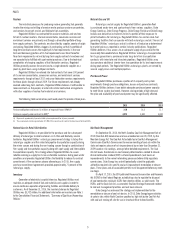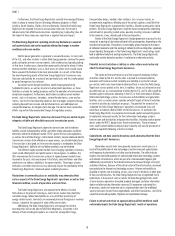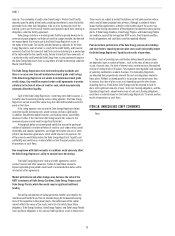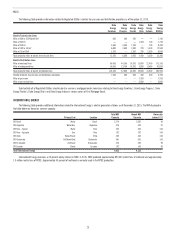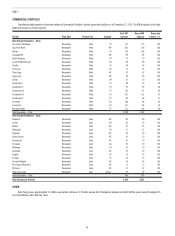Duke Energy 2015 Annual Report Download - page 35
Download and view the complete annual report
Please find page 35 of the 2015 Duke Energy annual report below. You can navigate through the pages in the report by either clicking on the pages listed below, or by using the keyword search tool below to find specific information within the annual report.
PART I
15
DUKE ENERGY INDIANA
Duke Energy Indiana is a regulated public utility primarily engaged in
the generation, transmission, distribution and sale of electricity in portions of
Indiana. Duke Energy Indiana’s service area covers 23,000 square miles and
supplies electric service to 810,000 residential, commercial and industrial
customers. See Item 2, “Properties” for further discussion of Duke Energy
Indiana’s generating facilities, transmission and distribution. Duke Energy
Indiana is subject to the regulatory provisions of the IURC and FERC.
Substantially all of Duke Energy Indiana’s operations are regulated and
qualify for regulatory accounting. Duke Energy Indiana operates one reportable
business segment, Regulated Utilities. For additional information regarding
this business segment, including financial information, see Note 3 to the
Consolidated Financial Statements, “Business Segments.”
ITEM 1A. RISK FACTORS
In addition to other disclosures within this Form 10-K, including
Management’s Discussion and Analysis – Matters Impacting Future Results
for each registrant in Item 7, and other documents filed with the SEC from time
to time, the following factors should be considered in evaluating Duke Energy
and its subsidiaries. Such factors could affect actual results of operations and
cause results to differ substantially from those currently expected or sought.
Unless otherwise indicated, risk factors discussed below generally relate to
risks associated with all of the Duke Energy Registrants. Risks identified at the
Subsidiary Registrant level are generally applicable to Duke Energy.
Duke Energy may be unable to obtain the approvals required to complete
its acquisition of Piedmont or, in order to do so, the combined company
may be required to comply with material restrictions or conditions.
On October 24, 2015, Duke Energy entered into a Merger Agreement
with Piedmont. For the acquisition to be completed, various approvals must
be obtained from state utility and regulatory authorities. These governmental
authorities may impose conditions on the completion, or require changes to the
terms, of the transaction, including restrictions or conditions on the business,
operations, or financial performance of the combined company following
completion of the transaction. These conditions or changes could have the
effect of delaying completion of the acquisition or imposing additional costs on
or limiting the revenues of the combined company following the transaction,
which could have a material adverse effect on the financial position, results of
operations or cash flows of the combined company and/or cause either Duke
Energy or Piedmont to abandon the transaction.
If completed, Duke Energy’s acquisition of Piedmont may not achieve its
intended results.
Duke Energy and Piedmont entered into the merger agreement with the
expectation that the transaction would result in various benefits, including,
among other things, being accretive to earnings and foundational to establishing
a broader gas infrastructure business within Duke Energy. Achieving the
anticipated benefits of the transaction is subject to a number of uncertainties,
including whether the business of Piedmont is integrated in an efficient and
effective manner. Failure to achieve these anticipated benefits could result in
increased costs; decreases in the amount of expected revenues generated by
the combined company and diversion of management’s time and energy, all
of which could have an adverse effect on the combined company’s financial
position, results of operations or cash flows.
Failure to complete the transaction with Piedmont could negatively impact
Duke Energy’s stock price and Duke Energy’s future business and financial
results.
If Duke Energy’s acquisition of Piedmont is not completed, Duke Energy’s
ongoing business and financial results may be adversely affected and Duke
Energy will be subject to a number of risks, including the following:
• Duke Energy may be required, under specified circumstances set forth in
the Merger Agreement, to pay Piedmont a termination fee of $250 million;
• Duke Energy will be required to pay costs relating to the transaction,
including legal, accounting, financial advisory, filing and printing costs,
whether or not the transaction is completed; and
• execution of Duke Energy’s acquisition of Piedmont (including integration
planning) may require substantial commitments of time and resources
by our management, which could otherwise have been devoted to other
opportunities that may have been beneficial to Duke Energy.
Duke Energy could also be subject to litigation related to any failure to
complete the transaction with Piedmont. If the transaction is not completed,
these risks may materialize and may adversely affect Duke Energy’s financial
position, results of operations or cash flows.
REGULATORY, LEGISLATIVE AND LEGAL RISKS
The Duke Energy Registrants’ regulated electric revenues, earnings and
results are dependent on state legislation and regulation that affect electric
generation, transmission, distribution and related activities, which may
limit their ability to recover costs.
The Duke Energy Registrants’ regulated utility businesses are regulated
on a cost-of-service/rate-of-return basis subject to statutes and regulatory
commission rules and procedures of North Carolina, South Carolina, Florida,
Ohio, Indiana and Kentucky. If the Duke Energy Registrants’ regulated utility
earnings exceed the returns established by the state utility commissions,
retail electric rates may be subject to review and possible reduction by the
commissions, which may decrease the Duke Energy Registrants’ future
earnings. Additionally, if regulatory bodies do not allow recovery of costs
incurred in providing service on a timely basis, the Duke Energy Registrants’
future earnings could be negatively impacted.
If legislative and regulatory structures were to evolve in such a way that
the Duke Energy Registrants’ exclusive rights to serve their regulated customers
were eroded, their future earnings could be negatively impacted. In addition,
federal and state regulations, laws and other efforts designed to promote
and expand the use of energy efficiency measures and distributed generation
technologies, such as rooftop solar and battery storage, in Duke Energy service
territories could result in customers leaving the electric distribution system and
an increased customer net energy metering, which allows customers with rooftop
solar to receive bill credits for surplus power at the full retail amount. Over time,
customer adoption of these technologies and increased energy efficiency could
result in excess generation resources as well as stranded costs if the Company is
not able to fully recover the costs and investment in generation.
Deregulation or restructuring in the electric industry may result in
increased competition and unrecovered costs that could adversely affect
the Duke Energy Registrants’ financial position, results of operations or
cash flows and their utility businesses.
Increased competition resulting from deregulation or restructuring
legislation could have a significant adverse impact on the Duke Energy
Registrants’ results of operations, financial position, or cash flows. Retail
competition and the unbundling of regulated electric service could have a
significant adverse financial impact on the Duke Energy Registrants due to
an impairment of assets, a loss of retail customers, lower profit margins or
increased costs of capital. The Duke Energy Registrants cannot predict the






